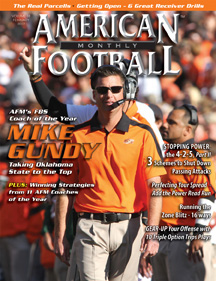AMERICAN FOOTBALL MONTHLY THE #1 RESOURCE FOR FOOTBALL COACHES
Article CategoriesAFM Magazine
|
Train Your Brain – Your Competitive Edge© More from this issueBy Dr. Calvin Ross, Co-Founder, MyXperts Offensive coordinators, coaches and quarterbacks call the plays within the game plan. At the line, the defense will attempt to fake, decoy and panic the quarterback as he reads the defensive to call the best play at that time. I am going to discuss PASS (Personal Athletic Stress Survey) and how your brain dominance plays into how your brain functions to give you the ultimate competitive edge. We will run two real basic plays demonstrating to you what strategies can happen at each stage of the play sequence, good or bad, to receive higher success statistics every....The full article can only be seen by subscribers.
|
|
|||||||
| HOME |
MAGAZINE |
SUBSCRIBE | ONLINE COLUMNISTS | COACHING VIDEOS |
Copyright 2025, AmericanFootballMonthly.com
All Rights Reserved





